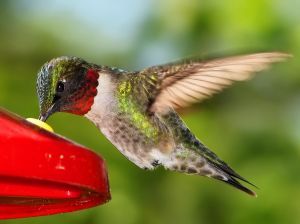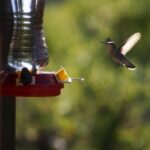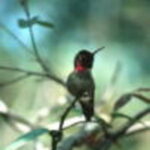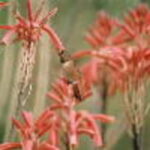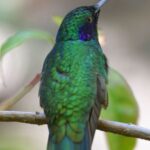The state of Wisconsin may be known for many things, but its population of hummingbirds is probably not one of them. There could be several reasons for this, such as hummingbirds being annual visitors or that are not many species that visit this state. There are actually four species of hummingbirds in Wisconsin who have been sighted and documented. These four species are the Ruby-throated Hummingbird, the Rufous Hummingbird, the Anna’s Hummingbird and the Green Violet-ear Hummingbird. Of these four species, only the Rufous Hummingbird and the Ruby-throated Hummingbird are commonly seen in Wisconsin. Identifying the hummingbird that chooses to visit a hummingbird can be exciting, and is not all that hard, especially when there are only a few species that visit a particular area.
To identify the Ruby-throated Hummingbird, it is easiest to begin with, the male of the species as he is more colorful than his female counterpart is. This male hummingbird is commonly known for his ruby-red throat, but he also has an emerald back, white breast and a forked tail. The female Ruby-throated Hummingbird is less colorful, but has her own characteristics which aide in her identification. She has the same emerald back and white breast as her male counterpart, but her throat is white and her tail is rounded with white-tips. Ruby-throated hummingbirds are usually seen in Wisconsin from April to September.
To identify the Rufous Hummingbird, the male is the easiest once again, as the male Rufous Hummingbird is also the most colorful of the species. This male hummingbird has an orange-red throat and rufous crown, tail and sides. It may also have a rufous, green or combination of rufous and green back and its breast is white. The female Rufous Hummingbird has a green back and crown, a white breast, a streaked throat and rufous tail feathers that are white tipped. The Rufous Hummingbird is a migrant species meaning that it is primarily seen in Wisconsin during migration periods and is only reported once every 3 to 5 years.
To identify the Anna’s Hummingbird, we will begin with the male once again. This male hummingbird has a rose-red throat, a gray breast, a rose-red crown and a metallic back. The female Anna’s Hummingbird has a lighter gray breast, a white with red spots throat, a green back and white tips on her tail feathers. This species of hummingbirds in Wisconsin is considered an accidental species, meaning that this species has been documented in Wisconsin less than 3 times or that this species is still questionable and more documented sightings will need to be recorded.
The Green-violet Eared Hummingbird is another accidental species of hummingbirds in Wisconsin, as it has only been documented a few times. Identifying this hummingbird can begin with its size, as it is the largest hummingbird to ever be seen in Wisconsin, weighing in at 5 to 6 grams. The other hummingbirds commonly seen in Wisconsin weigh in at around 3 grams. The male and female Green-violet Eared Hummingbird have very subtle differences in their color and markings, they have a shimmering pale green color that covers their throat and breast and a darker color of green that covers their crown. This species also has a violet ear patch that creates a triangular shape under its eye and extending down to its neck and a black band near the end of its yellow/green tipped tail feathers.
Attracting these hummingbirds to areas in Wisconsin can be as easy as preparing a hummingbird garden that includes plants with tubular, bright blooms, such as Columbine, with its showy, nodding flowers has red blooms during May and June or Butterfly weed with its orange-red blooms from June to September. Harebell has purple blooms from June to September and Turtlehead has white blooms from July to October. Purple coneflower has purple blooms from July to August while Fireweed has magenta colored blooms from July to September. Rough Blazing Star has purple blooms from July to September and Cardinal Flower has crimson red blooms from July to October. Great Blue Lobelia has blue blooms in from July to October, Wild Bergamot has lavender to pink blooms from July through August and Large-flowered Penstemon has lavender blooms from June through July. Obedient plant has pink blooms from July to October. Other plants to consider adding to a hummingbird garden are Spotted Jewelweed, Turk’s Cap Lily, Wood Lily, Lupine and Phlox.
Hummingbirds in Wisconsin
The state of Wisconsin may be known for many things, but its population of hummingbirds is probably not one of them. There could be several reasons for this, such as hummingbirds being annual visitors or that are not many species that visit this state. There are actually four species of hummingbirds in Wisconsin who have been sighted and documented. These four species are the Ruby-throated Hummingbird, the Rufous Hummingbird, the Anna’s Hummingbird and the Green Violet-ear Hummingbird. Of these four species, only the Rufous Hummingbird and the Ruby-throated Hummingbird are commonly seen in Wisconsin. Identifying the hummingbird that chooses to visit a hummingbird can be exciting, and is not all that hard, especially when there are only a few species that visit a particular area.
To identify the Ruby-throated Hummingbird, it is easiest to begin with, the male of the species as he is more colorful than his female counterpart is. This male hummingbird is commonly known for his ruby-red throat, but he also has an emerald back, white breast and a forked tail. The female Ruby-throated Hummingbird is less colorful, but has her own characteristics which aide in her identification. She has the same emerald back and white breast as her male counterpart, but her throat is white and her tail is rounded with white-tips. Ruby-throated hummingbirds are usually seen in Wisconsin from April to September.
To identify the Rufous Hummingbird, the male is the easiest once again, as the male Rufous Hummingbird is also the most colorful of the species. This male hummingbird has an orange-red throat and rufous crown, tail and sides. It may also have a rufous, green or combination of rufous and green back and its breast is white. The female Rufous Hummingbird has a green back and crown, a white breast, a streaked throat and rufous tail feathers that are white tipped. The Rufous Hummingbird is a migrant species meaning that it is primarily seen in Wisconsin during migration periods and is only reported once every 3 to 5 years.
To identify the Anna’s Hummingbird, we will begin with the male once again. This male hummingbird has a rose-red throat, a gray breast, a rose-red crown and a metallic back. The female Anna’s Hummingbird has a lighter gray breast, a white with red spots throat, a green back and white tips on her tail feathers. This species of hummingbirds in Wisconsin is considered an accidental species, meaning that this species has been documented in Wisconsin less than 3 times or that this species is still questionable and more documented sightings will need to be recorded.
The Green-violet Eared Hummingbird is another accidental species of hummingbirds in Wisconsin, as it has only been documented a few times. Identifying this hummingbird can begin with its size, as it is the largest hummingbird to ever be seen in Wisconsin, weighing in at 5 to 6 grams. The other hummingbirds commonly seen in Wisconsin weigh in at around 3 grams. The male and female Green-violet Eared Hummingbird have very subtle differences in their color and markings, they have a shimmering pale green color that covers their throat and breast and a darker color of green that covers their crown. This species also has a violet ear patch that creates a triangular shape under its eye and extending down to its neck and a black band near the end of its yellow/green tipped tail feathers.
Attracting these hummingbirds to areas in Wisconsin can be as easy as preparing a hummingbird garden that includes plants with tubular, bright blooms, such as Columbine, with its showy, nodding flowers has red blooms during May and June or Butterfly weed with its orange-red blooms from June to September. Harebell has purple blooms from June to September and Turtlehead has white blooms from July to October. Purple coneflower has purple blooms from July to August while Fireweed has magenta colored blooms from July to September. Rough Blazing Star has purple blooms from July to September and Cardinal Flower has crimson red blooms from July to October. Great Blue Lobelia has blue blooms in from July to October, Wild Bergamot has lavender to pink blooms from July through August and Large-flowered Penstemon has lavender blooms from June through July. Obedient plant has pink blooms from July to October. Other plants to consider adding to a hummingbird garden are Spotted Jewelweed, Turk’s Cap Lily, Wood Lily, Lupine and Phlox.
